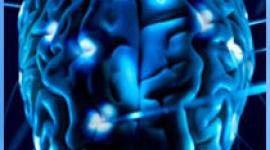Can ECT Permanently Harm the Brain?
Donald I. Templer and David M. Veleber
Clinical Neuropsychology (1982) 4(2): 62-66
Literature relevant to the question of whether ECT permanently injures the brain was reviewed. Similar histological findings of epileptics and patients who had received ECT were discussed. Experimental research with animals seems to have demonstrated both reversible and nonreversible pathology. Psychological test findings, even when attempting to control for possible pre-ECT differences, seem to suggest some permanent cognitive deficit. Reports of spontaneous seizures long after ECT would appear to point to permanent brain changes. Human brain autopsies sometimes indicate and sometimes do not indicate lasting effects. It was concluded that vast individual differences are salient, that massive damage in the typical ECT patient is unlikely, and that irreversible changes probably do occur in some patients.
 This review centers around five areas germane to the question of whether electroconvulsive therapy (ECT) causes permanent brain pathology. Relatively indirect evidence is provided by two of these areas, the brain condition of epileptics and the examination of animal brains after experimental ECT. The other three areas are psychological testing findings with history of many ECTs, spontaneous seizures, and autopsy findings. The review does not concern the extensive literature that shows that ECT temporarily impairs cognitive functioning. Such literature eventually shows impairment beginning with the first ECT and becoming progressively worse with succeeding treatments. Improvement occurs following the course of ECT, sometimes with the tested functioning actually being higher than the pretreatment level, which is presumed to have been impaired by psychopathology such as thought disorder and depression. Reviews of this literature can be found elsewhere (American Psychiatric Association, 1978; Campbell, 1961; Dornbush, 1972; Dornbush and Williams, 1974; Harper and Wiens, 1975), as can reviews indicating that the unilateral ECT (applied to the right side) in increasing usage in recent years causes less impairment than bilateral ECT (American Psychiatric Association, 1978; d'Elia, 1974; Hurwitz, 1974; Zamora and Kaelbing, 1965). This literature is really not very relevant to the central issue of our review. It has never been disputed that cognitive impairment occurs after ECT. Even the most fervent and excathedra defenders acknowledge that "temporary" impairment occurs. It is the issue of permanency that has been controversial.
This review centers around five areas germane to the question of whether electroconvulsive therapy (ECT) causes permanent brain pathology. Relatively indirect evidence is provided by two of these areas, the brain condition of epileptics and the examination of animal brains after experimental ECT. The other three areas are psychological testing findings with history of many ECTs, spontaneous seizures, and autopsy findings. The review does not concern the extensive literature that shows that ECT temporarily impairs cognitive functioning. Such literature eventually shows impairment beginning with the first ECT and becoming progressively worse with succeeding treatments. Improvement occurs following the course of ECT, sometimes with the tested functioning actually being higher than the pretreatment level, which is presumed to have been impaired by psychopathology such as thought disorder and depression. Reviews of this literature can be found elsewhere (American Psychiatric Association, 1978; Campbell, 1961; Dornbush, 1972; Dornbush and Williams, 1974; Harper and Wiens, 1975), as can reviews indicating that the unilateral ECT (applied to the right side) in increasing usage in recent years causes less impairment than bilateral ECT (American Psychiatric Association, 1978; d'Elia, 1974; Hurwitz, 1974; Zamora and Kaelbing, 1965). This literature is really not very relevant to the central issue of our review. It has never been disputed that cognitive impairment occurs after ECT. Even the most fervent and excathedra defenders acknowledge that "temporary" impairment occurs. It is the issue of permanency that has been controversial.
THE BRAINS OF EPILEPTICS
It would seem that if an epileptic grand mal seizure produces permanent brain changes, then an electrically induced convulsion should also do so. In fact, inspecting the evidence with respect to epileptics may provide us with a conservative perspective in regard to ECT since the latter could produce damage from the externally applied electrical current as well as from the seizure. Experimental research with animals has shown that the electric shocks (not to the head) produce more deleterious effects in the central nervous system than any other locality or system of the body. More pertinent are the studies of Small (1974) and of Laurell (1970) that found less memory impairment after inhalant induced convulsions than ECT. And, Levy, Serota and Grinker (1942) reported less EEG abnormality and intellectual impairment with pharmacologically induced convulsions. Further argument provided by Friedberg (1977) is the case (Larsen and Vraa-Jensen, l953) of a man who had been given four ECTs, but did not convulse. When he died three days later, a subarachnoid hemorrhage was found in the upper part of the left motor region at the site where an electrode had been applied.
A number of post-mortem reports on epileptics, as reviewed by Meldrum, Horton, and Brierley (1974) have indicated neuronal loss and gliosis, especially in the hippocampus and temporal lobe. However, as Meldrum et al. pointed out, on the basis of these post-mortem reports, one does not know whether the damage was caused by the seizures or whether both were caused by a third factor intrinsic to the epilepsy. To clarify this issue, Meldrum et al. pharmacologically induced seizures in baboons and found cell changes that corresponded to those in human epileptics.
Gastaut and Gastaut (1976) demonstrated through brain scans that in seven of 20 cases status epilepticus produced brain atrophy. They reasoned that "Since the edema and the atrophy were unilateral or bilateral and related to the localization of the convulsions (unilateral or bilateral chronic seizures), the conclusion can be drawn that the atrophic process depends upon the epileptic process and not on the cause of the status."
A common finding in epileptics and ECT patients is noteworthy. Norman (1964) stated that it is not uncommon to find at autopsy both old and recent lesions in the brains of epileptics. Alpers and Hughes (1942) reported old and recent brain lesions associated with different series of ECT.
ANIMAL BRAINS
There are a number of articles concerning the application of ECT and subsequent brain examination in animals. In the 15 study review of Hartelius (1952), 13 of the 15 reported pathological findings that were vascular, glial or neurocytological, or (as was generally the case) in two or three of these domains. However, as Hartelius pointed out, inferences of these studies tended to be conflicting because of different methods used and because of deficient controls. The research that Hartelius himself carried out was unquestionably the outstanding study in the area with respect to methodological sophistication and rigor. Hartelius employed 47 cats; 31 receiving ECT, and 16 being control animals. To prevent artifacts associated with the sacrificing of the animals, the cerebrums were removed under anesthesia while the animals were still alive. Brain examinations were conducted blindly with respect to ECT vs. control of subject. On a number of different vascular, glial, and neuronal variables, the ECT animals were significantly differentiated from the controls. The animals that had 11-16 ECTs had significantly greater pathology than the animals that had received four ECTs. Most of the significant differences with respect to reversible type changes. However, some of the significant differences pertained to clearly irreversible changes such as shadow cells and neuronophagia.
PSYCHOLOGICAL TEST FINDINGS WITH HISTORY OF MANY ECTS
There have been several studies regarding the administration of psychological tests to patients with a history of many ECTs. Unfortunately, all were not well controlled. Rabin (1948) administered the Rorschach to six chronic schizophrenics with a history of from 110 to 234 ECTs. Three patients had 6, two had 4, and one had 2 Piotrowski signs. (Piotrowski regards five or more as indicating organicity.) However, control subjects were not employed. Perlson (1945) reported the case of a 27-year-old schizophrenic with a history of 152 ECTs and 94 Metrozol convulsions. At age 12 he received an IQ of 130 on the Stanford Achievement Test; at age 14 an IQ of 110 on an unspecified general intelligence test. At the time of the case study, he scored at the 71st percentile on the Otis, at the 65th percentile on the American Council on Educational Psychological Examination, at the 77th percentile on the Ohio State Psychological Examination, at the 95th percentile for engineering freshman on the Bennett Test of Mechanical Comprehension, at the 20th percentile on engineering senior norms and at the 55th percentile on liberal arts students' norm on a special perception test. These facts led Perlson to conclude that convulsive therapy does not lead to intellectual deterioration. A more appropriate inference would be that, because of the different tests of different types and levels and norms given at different ages in one patient, no inference whatsoever is justified.
There are two studies that provide more methodological sophistication than the above described articles. Goldman, Gomer, and Templer (1972) administered the Bender-Gestalt and the Benton Visual Retention Test to schizophrenics in a VA hospital. Twenty had a past history of from 50 to 219 ECTs and 20 had no history of ECT. The ECT patients did significantly worse on both instruments. Furthermore, within the ECT groups there were significant inverse correlations between performance on these tests and number of ECTs received. However, the authors acknowledged that ECT-caused brain damage could not be conclusively inferred because of the possibility that the ECT patients were more psychiatrically disturbed and for this reason received the treatment. (Schizophrenics tend to do poorly on tests of organicity.) In a subsequent study aimed at ruling out this possibility, Templer, Ruff, and Armstrong (1973) administered the Bender-Gestalt, the Benton, and the Wechsler Adult Intelligence Scale to 22 state hospital schizophrenics who had a past history of from 40 to 263 ECTs and to 22 control schizophrenics. The ECT patients were significantly inferior on all three tests. However, the ECT patients were found to be more psychotic. Nevertheless, with degree of psychosis controlled for, the performance of the ECT patients was still significantly inferior on the Bender-Gestalt, although not significantly so on the other two tests.
SPONTANEOUS SEIZURES
It would appear that if seizures that were not previously evidenced appeared after ECT and persisted, permanent brain pathology must be inferred. There have been numerous cases of post-ECT spontaneous seizures reported in the literature and briefly reviewed by Blumenthal (1955, Pacella and Barrera (1945), and Karliner (1956). It appears that in the majority of cases the seizures do not persist indefinitely, although an exact perspective is difficult to obtain because of anticonvulsant medication employed and the limited follow-up information. another difficulty is, in all cases, definitively tracing the etiology to the ECT, since spontaneous seizures develop in only a very small proportion of patients given this treatment. Nevertheless, the composite of relevant literature does indicate that, at least in some patients, no evidence of seizure potential existed before treatment and post-ECT seizures persist for years.
An article that is one of the most systematic and representative in terms of findings is that of Blumenthal (1955) who reported on 12 schizophrenic patients in one hospital who developed post-ECT convulsions. Six of the patients had previous EEGs with four of them being normal, one clearly abnormal, and one mildly abnormal. The patients averaged 72 ECTs and 12 spontaneous seizures. The time from last treatment to first spontaneous seizure ranged from 12 hours to 11 months with an average of 2 and 1/2 months. The total duration of spontaneous seizures in the study period ranged from 1 day to 3 and 1/2 years with an average of 1 year. Following the onset of seizures, 8 of the 12 patients were found to have a clearly abnormal, and 1 a mildly abnormal EEG.
Mosovich and Katzenelbogen (1948) reported that 20 of their 82 patients had convulsive pattern cerebral dysrhythmia 10 months post ECT. None had such in their pre-treatment EEG. Nine (15%) of the 60 patients who had 3 to 15 treatments, and 11(50%) of the 22 patients who had from 16 to 42 treatments had this 10 month posttreatment dysrhythmia.
HUMAN BRAIN AUTOPSY REPORTS
In the 1940s and 1950s there were a large number of reports concerning the examination of brains of persons who had died following ECT. Madow (1956) reviewed 38 such cases. In 31 of the 38 cases there was vascular pathology. However, much of this could have been of a potentially reversible nature. Such reversibility was much less with the 12 patients who had neuronal and/or glial pathology. The following are the comments pertaining to the neuronal and glial pathology and the amount of time between last treatment and death: "Gliosis and fibrosis" (5 months); "Small areas of cortical devastation, diffuse degeneration of nerve cells", "Astrocytic proliferation" (1 hour, 35 minutes); "Small areas of recent necrosis in cortex, hippocampus and medulla", "Astrocytic proliferation" (immediate); "Central chromatolysis, pyknosis, shadow cells (15 to 20 minutes); "Shrinking and swelling. ghost cells", "Satellitosis and neuronophagia" (7 days); "Chromatolysis, cell shrinkage''. "Diffuse gliosis, glial nodules beneath the ependyma of the third ventricle" (15 days); "Increased Astrocytes" (13 days); "Schemic and pyknotic ganglion cells" (48 hours); "Pigmentation and fatty degeneration, sclerotic and ghost cells", "Perivascular and pericellular gliosis" (10 minutes); "Decrease in ganglion cells in frontal lobes, lipoid pigment in globus pallidus and medical nucleus of thalamus", "Moderate glial proliferation" (36 hours); "Glial fibrosis in marginal layer of cortex, gliosis around ventricles and in marginal areas of brain stem, perivascular gliosis in white matter" (immediate); "Marginal proliferation of astrocytes, glial fibrosis around blood vessels of white matter, gliosis of thalamus, brain stem and medulla" (immediate). In one case the author (Riese, 1948), in addition to giving the neuronal and glial changes, reported numerous slits and rents similar to that seen after execution. Needless to say, patients who died following ECT are not representative of patients receiving ECT. They tended to be in inferior physical health. Madow concluded, on the basis of these 38 cases and 5 of his own, "If the individual being treated is well physically, most of the neuropathological changes are reversible. If, on the other hand, the patient has cardiac, vascular, or renal disease, the cerebral changes, chiefly vascular, may be permanent."
CONCLUSION
A wide array of research and clinical based facts that provide suggestive to impressive evidence in isolation, provide compelling evidence when viewed in a composite fashion. Some human and animal autopsies reveal permanent brain pathology. Some patients have persisting spontaneous seizures after having received ECT. Patients having received many ECTs score lower than control patients on psychological tests of organicity, even when degree of psychosis is controlled for.
A convergence of evidence indicates the importance of number of ECTs. We have previously referred to the significant inverse correlations between number of ECTs and scores on psychological tests. It is conceivable that this could be a function of the more disturbed patients receiving more ECTs and doing more poorly on tests. However, it would be much more difficult to explain away the relationship between number of ECTs received and EEG convulsive pattern dysrhythmia (Mosovich and Katzenelbogen, 1948). No patients had dysrhythmia prior to ECTs. Also difficult to explain away is that in Table I of Meldrum, Horton and Brierley (1974), the nine baboons who suffered brain damage from experimentally administrated convulsions tended to have received more convulsions than the five that did not incur damage. (According to our calculations, U=9, p < .05 ) And, as already stated, Hartelius found greater damage, both reversible and irreversible, in cats that were given 11 to l6 than in those given 4 ECTs.
Throughout this review the vast individual differences are striking. In the animal and human autopsy studies there is typically a range of findings from no lasting effect to considerable lasting damage with the latter being more of the exception. Most ECT patients don't have spontaneous seizures but some do. The subjective reports of patients likewise differ from those of no lasting effect to appreciable, although usually not devastating impairment. The fact that many patients and subjects suffer no demonstrable permanent effects has provided rationale for some authorities to commit the non-sequitur that ECT causes no permanent harm.
There is evidence to suggest that pre-ECT physical condition accounts in part for the vast individual differences. Jacobs (1944) determined the cerebrospinal fluid protein and cell content before, during, and after a course of ECT with 21 patients. The one person who developed abnormal protein and cell elevations was a 57-year-old diabetic, hypertensive, arteriosclerotic woman. Jacobs recommended that CSF protein and cell counts be ascertained before and after ECT in patients with significant degree of arteriosclerotic or hypertensive disease. Alpers (1946) reported, "Autopsied cases suggest that brain damage is likely to occur in conditions with pre-existing brain damage, as in cerebral arteriosclerosis." Wilcox (1944) offered the clinical impression that, in older patients, ECT memory changes continue for a longer time than for younger patients. Hartelius (1952) found significantly more reversible and irreversible brain changes following ECT in older cats than younger cats. Mosovich and Katzenelbogen (1948) found that patients with pretreatment EEG abnormalities are more likely to show marked post-ECT cerebral dysrhythmia and to generally show EEGs more adversely affected by treatment.
In spite of the abundance of evidence that ECT sometimes causes brain damage, the Report of The Task Force on Electroconvulsive Therapy of the American Psychiatric Association (1978) makes a legitimate point in stating that the preponderance of human and animal autopsy studies were carried out prior to the modern era of ECT administration that included anesthesia, muscle relaxants, and hyperoxygenation. In fact, animals which were paralyzed and artificially ventilated on oxygen had brain damage of somewhat lesser magnitude than, although similar patterns as, animals not convulsed without special measures. (Meldrum and Brierley, 1973; Meldrum, Vigourocex, Brierley, 1973). And it could further be maintained that the vast individual differences stressed above argue for the possibility of making ECT very safe for the brain through refinement of procedures and selection of patients. Regardless of such optimistic possibilities, our position remains that ECT has caused and can cause permanent pathology.
next: Can Taped Goggles Heal Emotional Disorders?
~ all Shocked! ECT articles
~ depression library articles
~ all articles on depression
APA Reference
Staff, H.
(2007, February 17). Can ECT Permanently Harm the Brain?, HealthyPlace. Retrieved
on 2025, December 30 from https://www.healthyplace.com/depression/articles/can-ect-permanently-harm-the-brain



